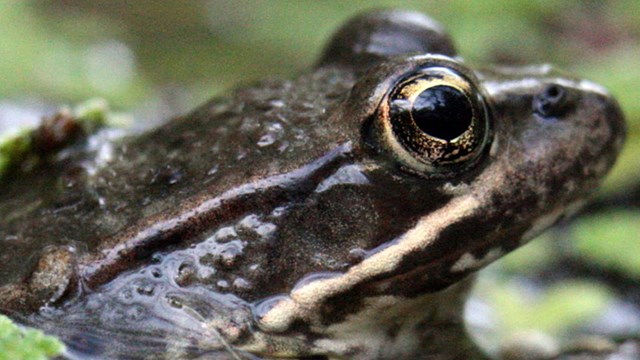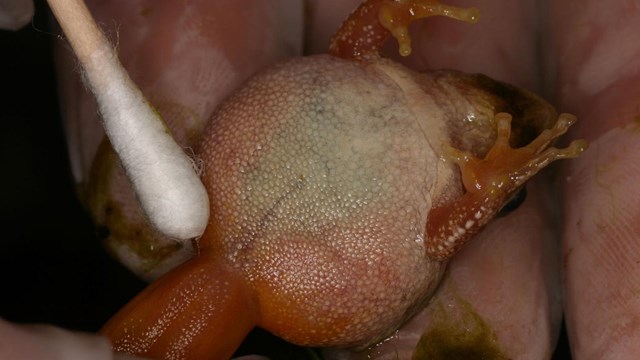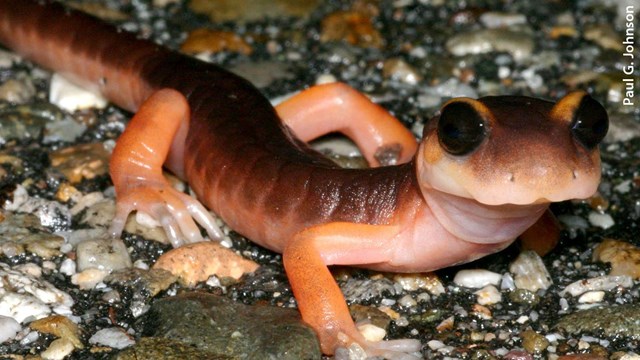
Photo by Gavin Emmons Amphibian Life in Pinnacles' Dry HabitatAt first glance, Pinnacles National Park may not seem like a place for amphibians. Nevertheless, eight species of these moist-skinned creatures inhabit this land of hot, dry summers and only sixteen inches of rain per year. Species OverviewThe Pacific tree frog (Pseudacris regilla), California red-legged frog (Rana draytonii), and western toad (Bufo boreas) breed in streams and ponds. While the two frog species remain close to water, the toad migrates away after breeding. Terrestrial species such as the arboreal salamander (Aneides lugubris), ensatina (Ensatina eschscholtzii), and the recently described Gabilan slender salamander (Batrachoseps gavilanensis) spend their entire lives away from water, laying eggs in moist areas like decaying logs. These species are fairly common but rarely seen due to their secretive nature. Additionally, the California tiger salamander (Ambystoma californiense) and western spadefoot (Spea hammondii) inhabit grasslands and occasionally breed in seasonal ponds on the park's eastern edge. Best Times to ObserveThe best time to spot amphibians at Pinnacles is on warm, rainy nights, especially in November and March. They may also be active during the day in the rainy season. Western toads are often seen in the evening through May. California red-legged frogs are uncommon, typically found near ponds and deep stream sections during spring and summer. Pacific tree frogs are abundant near streams and ponds and can be heard calling during most months except the driest ones. These frogs are both the smallest and loudest species at the park, with tadpoles frequently visible in spring and early summer. Red-legged frog and western toad tadpoles are more limited in range, found in only a few park locations. The red-legged frog is listed as a Threatened species under the Endangered Species Act, and efforts to re-establish them at Bear Gulch Reservoir have shown positive results. Additional SpeciesSeveral other amphibians are noteworthy. Foothill yellow-legged frogs were once abundant in the park’s streams but have not been seen in several decades; a re-establishment plan is under consideration. The California newt, although common across the Salinas Valley and nearby Hollister Hills SVRA, is absent in this area. The non-native American bullfrog (Rana catesbiana) once inhabited Bear Gulch Reservoir and nearby ponds. Occasionally, bullfrog tadpoles are washed into park streams during floods, but they have been eradicated before becoming established. Observation EtiquetteIf you encounter an amphibian at Pinnacles, observe from a distance. Their moist skin is sensitive, and contact with salts, oils, sunscreens, or soaps on your hands can harm them. Avoid turning over rocks or logs or attempting to catch them. Little is known about their diet, burrowing habits, and other behaviors. If you observe any such behavior or encounter an unusual species, please take detailed notes and inform a park employee. 
California Red-Legged Frogs
Thanks to conservation and restoration efforts, Bear Gulch Reservoir is now a haven for this threatened frog species. 
Amphibian Chytrid Fungus
This fungal disease is killing frogs around the world, and several frog species at Pinnacles have tested positive. 
Reptile and Amphibians Checklist
Explore this comprehensive list of the reptile and amphibian species we know to be present at Pinnacles. |
Last updated: October 23, 2024
